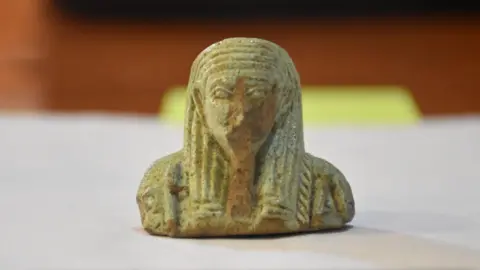Angela Ferguson
BBC News, Manchester

 University of Manchester / Dr Nicky Nielsen
University of Manchester / Dr Nicky Nielsen
An ancient Egyptian city has been uncovered by a team of British and Egyptian archaeologists.
Archaeologists from the University of Manchester worked alongside a team from the University of Sadat City in Cairo to excavate the ancient city of Imet in the eastern Nile Delta.
The team combined remote sensing using high-resolution satellite imagery with on-the-ground archaeology, unearthing artefacts including a cooking pot complete with the remains of a 4th century BC fish stew.
Project lead Dr Nicky Nielsen said: "Imet is emerging as a key site for rethinking the archaeology of Late Period Egypt."
"This discovery opens new doors to our understanding of daily life, spirituality and urban planning in the Delta," he added.
Dr Nielsen said the cooking pot they found contained tilapia bones and it was found still in place on a hearth.
Next to it were platters where bread would have been leavened in the sun, he added.
Dr Nielsen said: "When you take it out of the ground and you are the first person to touch it in 2,500 years then it does give you a bit of a jolt."
He said archaeologists first excavated the area in the 1800s but they had focused on the nearby temple site and cemetery rather than the settlement.
Dr Nielsen and his team also uncovered multi-storey homes, along with granaries and a ceremonial road linked to the worship of the cobra goddess Wadjet.

 University of Manchester / Dr Nicky Nielsen
University of Manchester / Dr Nicky Nielsen
Among the other artefacts uncovered during excavations at Tell el-Fara'in, also known as Tell Nabasha, was a shabti figurine made out of green faience ceramic, which would have been intended for a tomb.
This figurine dates from the 26th Dynasty, which was the late Egyptian period around 2,300 years ago.
Shabti figurines were inscribed with a spell and put in the tombs of high ranking officials in the belief that they would be servants for the deceased during the afterlife, when they believed they would be expected to do agricultural work.
"They were a way of getting out of labour in the afterlife," said Dr Nielsen.
Further artefacts excavated included a small amuletic tomb marker known as a steal, which depicts the god Harpocrates standing on top of two crocodiles with the head of the god Bes above him.
This amulet was intended to protect against disease.
They also unearthed a bronze sistrum, which is a kind of metal rattle used in temples.
This was adorned with the twin heads of Hathor, goddess of music and joy.
Dr Nielsen said they reflected a vibrant spiritual culture.

 University of Manchester / Dr Nicky Nielsen
University of Manchester / Dr Nicky Nielsen
Dr Nielsen said that by combining remote sensing with on-the-ground archaeology, the team had begun to transform understanding of the urban, religious and economic life of this city in the Nile Delta during the 4th Century BCE.
The team used high-resolution satellite imagery to identify clusters of ancient mud bricks prior to excavation.
This led to the discovery of dense architectural remains, including substantial tower houses, which were multi-storey buildings supported by exceptionally thick foundation walls.
"These tower houses are mainly found in the Nile Delta between the Late Period and the Roman era, and are rare elsewhere in Egypt," said Dr. Nielsen.
"Their presence here shows that Imet was a thriving and densely-built city with a complex urban infrastructure."
Additional discoveries include a paved area for grain processing and animal enclosures, pointing to an active local economy alongside its religious significance.

 University of Manchester / Dr Nicky Nielsen
University of Manchester / Dr Nicky Nielsen
Dr Nielsen said that elsewhere, excavators found a large building with a limestone plaster floor and "massive pillars" dating to the mid-Ptolemaic Period offering insights into shifting religious landscapes in ancient Egypt.
A University of Manchester spokesperson said their involvement in the project continued to shape global narratives of Egypt's forgotten cities, "bringing the ancient Delta back into view one discovery at a time".
The excavation team also comprised Dr Diana Nikolova from the University of Liverpool among other researchers from around the world.







